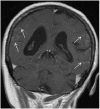Leptomeningeal Relapse of Acute Promyelocytic Leukemia
- PMID: 29147382
- PMCID: PMC5649878
- DOI: 10.14740/wjon761w
Leptomeningeal Relapse of Acute Promyelocytic Leukemia
Abstract
Extramedullary relapse (EMR) of acute promyelocytic leukemia (APL) is a rare entity, with predilection to involve the central nervous system (CNS). Risk factors include leukocytosis of > 10 × 109/L, bcr3 isoform, microgranular variant, age > 45 years and development of subarachnoid hemorrhage (SAH) during induction therapy. We report a case of APL who completed induction and consolidation therapy but subsequently relapsed with leptomeningeal involvement. Retrospectively, we identified several risk factors for EMR in our patient. Interestingly, the use of all-trans retinoic acid has recently been associated with higher risk of EMR possibly due to up-regulation of adhesion molecules on the surface of the leukemic cell, resulting in their passage through the endothelium to extramedullary tissues. However, data remain conflicting in that regard. Although universal CNS prophylaxis has been suggested, the low incidence of EMR among APL patients renders this strategy less attractive. Nonetheless, active surveillance and CNS prophylaxis may be considered in patients at high risk for EMR, particularly in those of SAH during induction therapy. Further research is needed to evaluate the effectiveness and safety of this strategy.
Keywords: Acute promyelocytic leukemia; Extramedullary relapse; Leptomeningeal relapse.
Figures
Similar articles
-
Extramedullary relapse in acute promyelocytic leukemia treated with all-trans retinoic acid and chemotherapy.Leukemia. 2006 Jan;20(1):35-41. doi: 10.1038/sj.leu.2404006. Leukemia. 2006. PMID: 16307026 Clinical Trial.
-
Arsenic trioxide is required in the treatment of newly diagnosed acute promyelocytic leukemia. Analysis of a randomized trial (APL 2006) by the French Belgian Swiss APL group.Haematologica. 2018 Dec;103(12):2033-2039. doi: 10.3324/haematol.2018.198614. Epub 2018 Jul 19. Haematologica. 2018. PMID: 30026341 Free PMC article. Clinical Trial.
-
Extramedullary relapse after all-trans retinoic acid treatment in acute promyelocytic leukemia--the occurrence of retinoic acid syndrome is a risk factor.Leukemia. 1999 Sep;13(9):1406-8. doi: 10.1038/sj.leu.2401495. Leukemia. 1999. PMID: 10482992
-
Extramedullary disease in APL: a real phenomenon to contend with or not?Best Pract Res Clin Haematol. 2014 Mar;27(1):63-8. doi: 10.1016/j.beha.2014.04.001. Epub 2014 Apr 12. Best Pract Res Clin Haematol. 2014. PMID: 24907018 Review.
-
Cutaneous promyelocytic sarcoma at sites of vascular access and marrow aspiration. A characteristic localization of chloromas in acute promyelocytic leukemia?Haematologica. 2000 Jul;85(7):758-62. Haematologica. 2000. PMID: 10897129 Review.
References
-
- Douer D, Zickl LN, Schiffer CA, Appelbaum FR, Feusner JH, Shepherd L, Willman CL. et al. All-trans retinoic acid and late relapses in acute promyelocytic leukemia: very long-term follow-up of the North American Intergroup Study I0129. Leuk Res. 2013;37(7):795–801. doi: 10.1016/j.leukres.2013.03.001. - DOI - PMC - PubMed
-
- Mandelli F, Diverio D, Avvisati G, Luciano A, Barbui T, Bernasconi C, Broccia G. et al. Molecular remission in PML/RAR alpha-positive acute promyelocytic leukemia by combined all-trans retinoic acid and idarubicin (AIDA) therapy. Gruppo Italiano-Malattie Ematologiche Maligne dell'Adulto and Associazione Italiana di Ematologia ed Oncologia Pediatrica Cooperative Groups. Blood. 1997;90(3):1014–1021. - PubMed
-
- Specchia G, Lo Coco F, Vignetti M, Avvisati G, Fazi P, Albano F, Di Raimondo F. et al. Extramedullary involvement at relapse in acute promyelocytic leukemia patients treated or not with all-trans retinoic acid: a report by the Gruppo Italiano Malattie Ematologiche dell'Adulto. J Clin Oncol. 2001;19(20):4023–4028. - PubMed
Publication types
LinkOut - more resources
Full Text Sources
Other Literature Sources


